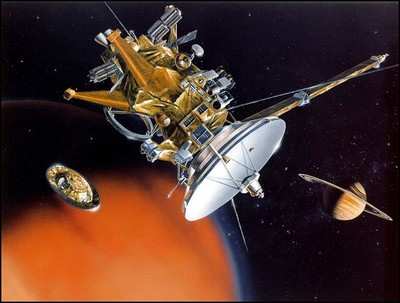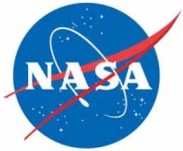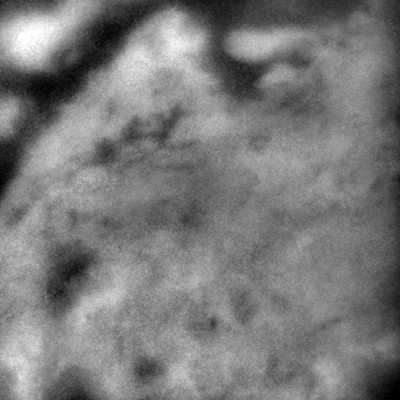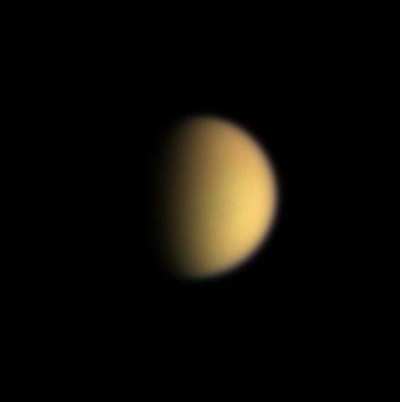Ammonia-Laced Water May Lie 62 Miles Under Surface
NASA tells ANN the Cassini spacecraft has discovered evidence
that points to the existence of an underground ocean of water and
ammonia on Saturn's moon Titan. The findings, made using radar
measurements of Titan's rotation, will appear in the March 21 issue
of the journal Science.

"With its organic dunes, lakes, channels and mountains, Titan
has one of the most varied, active and Earth-like surfaces in the
solar system," said Ralph Lorenz, lead author of the paper and
Cassini radar scientist at the Johns Hopkins Applied Physics
Laboratory in Laurel, MD. "Now we see changes in the way Titan
rotates, giving us a window into Titan's interior beneath the
surface."
 Members of the mission's science team used Cassini's Synthetic
Aperture Radar to collect imaging data during 19 separate passes
over Titan between October 2005 and May 2007. The radar can see
through Titan's dense, methane-rich atmospheric haze, detailing
never-before-seen surface features and establishing their locations
on the moon's surface.
Members of the mission's science team used Cassini's Synthetic
Aperture Radar to collect imaging data during 19 separate passes
over Titan between October 2005 and May 2007. The radar can see
through Titan's dense, methane-rich atmospheric haze, detailing
never-before-seen surface features and establishing their locations
on the moon's surface.
Using data from the radar's early observations, the scientists
and radar engineers established the locations of 50 unique
landmarks on Titan's surface. They then searched for these same
lakes, canyons and mountains in the reams of data returned by
Cassini in its later flybys of Titan. They found prominent surface
features had shifted from their expected positions by up to 30
kilometers (19 miles). A systematic displacement of surface
features would be difficult to explain unless the moon's icy crust
was decoupled from its core by an internal ocean, making it easier
for the crust to move.
"We believe that about 100 kilometers (62 miles) beneath the ice
and organic-rich surface is an internal ocean of liquid water mixed
with ammonia," said Bryan Stiles of NASA's Jet Propulsion
Laboratory in Pasadena, CA. Stiles is a contributing author to the
paper.

The study of Titan is a major goal of the Cassini-Huygens
mission because it may preserve, in deep-freeze, many of the
chemical compounds that preceded life on Earth. Titan is the only
moon in the solar system that possesses a dense atmosphere. The
moon's atmosphere is 1.5 times denser than Earth's. Titan is the
largest of Saturn's moons, bigger than the planet Mercury.
"The combination of an organic-rich environment and liquid water
is very appealing to astrobiologists," Lorenz said. "Further study
of Titan's rotation will let us understand the watery interior
better, and because the spin of the crust and the winds in the
atmosphere are linked, we might see seasonal variation in the spin
in the next few years."
Cassini scientists will not have long to wait before another go
at Titan. On March 25, just prior to its closest approach at an
altitude of 1,000 kilometers (620 miles), Cassini will employ its
Ion and Neutral Mass Spectrometer to examine Titan's upper
atmosphere. Immediately after closest approach, the spacecraft's
Visual and Infrared Mapping Spectrometer will capture
high-resolution images of Titan's southeast quadrant.

The Cassini-Huygens mission is a cooperative project of NASA,
the European Space Agency and the Italian Space Agency. The mission
is managed by JPL, a division of the California Institute of
Technology in Pasadena. The Cassini orbiter also was designed,
developed and assembled at JPL. The radar instrument was built by
JPL and the Italian Space Agency, working with team members from
the United States and several European countries.
 ANN's Daily Aero-Linx (05.06.25)
ANN's Daily Aero-Linx (05.06.25) ANN's Daily Aero-Term (05.06.25): Ultrahigh Frequency (UHF)
ANN's Daily Aero-Term (05.06.25): Ultrahigh Frequency (UHF) ANN FAQ: Q&A 101
ANN FAQ: Q&A 101 Classic Aero-TV: Virtual Reality Painting--PPG Leverages Technology for Training
Classic Aero-TV: Virtual Reality Painting--PPG Leverages Technology for Training Airborne 05.02.25: Joby Crewed Milestone, Diamond Club, Canadian Pilot Insurance
Airborne 05.02.25: Joby Crewed Milestone, Diamond Club, Canadian Pilot Insurance






